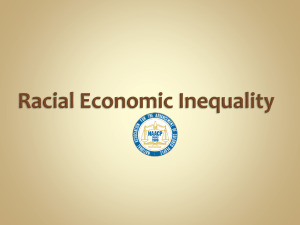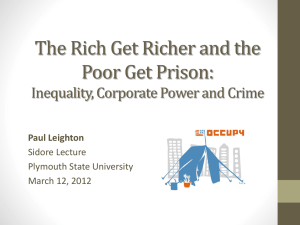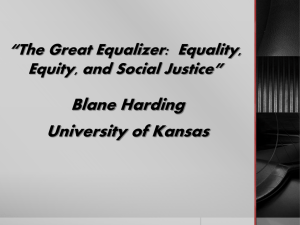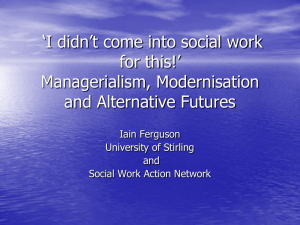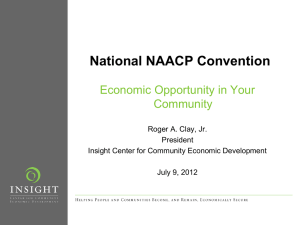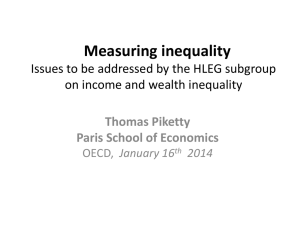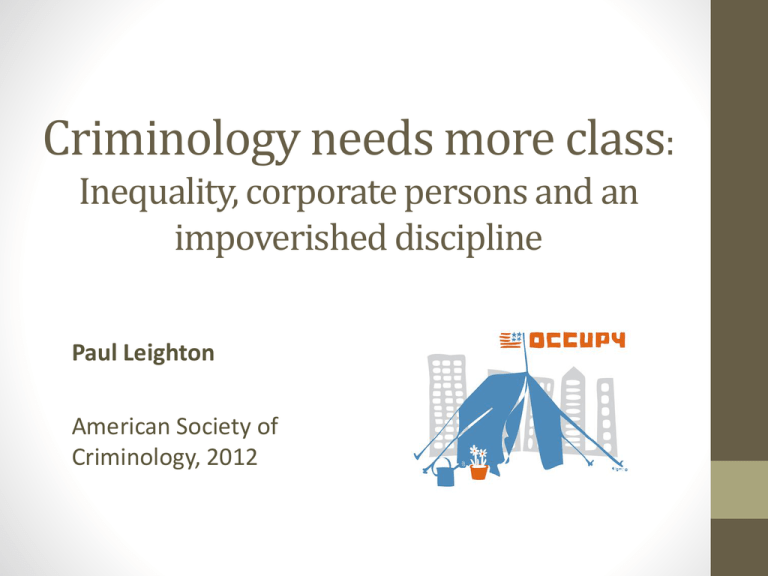
Criminology needs more class:
Inequality, corporate persons and an
impoverished discipline
Paul Leighton
American Society of
Criminology, 2012
This presentation is adapted from a longer invited
lecture,
The Rich Get Richer and the Poor Get Prison:
Inequality, Corporate Power and Crime
Available PaulsJusticeBlog.com
The creators of any graphics
used in this presentation
who want attribution or
removal should contact me
through my website,
http://paulsjusticepage.com.
For more about this
presentation, see
http://www.paulsjusticeblog.com/201
2/11/criminology_needs_more_class.
php.
• Class, Race & Gender are the ‘holy trinity,’ but social analysis
and criminology are effectively ‘de-classed’
• “the scale of this inequality is almost beyond comprehension,
perhaps not surprisingly as much of it remains hidden from view”
(Mooney 2008: 64).
• Class important because
• CJ can be no more fair than the society for
which it provides ‘law and order’ - reflect
and recreate injustices in social order
• Without attention to white collar and
corporate crime, we have the wrong
pictures of harms that threaten us and do
not pursue policies to advance public safety
• ‘Equality under law’ requires assessment of
class bias in CJ
• Inequality shapes patterns of offending in
ways theory and policy need to understand
http://occuprint.org/
Mooney, G. (2008) ‘Explaining poverty, social exclusion and inequality’ in T. Ridge and S. Wright (eds)
Understanding Inequality, Poverty and Wealth, Bristol (U.K.): Policy Press.
Roadmap
• Inequality
• Income
• Wealth
• Corporate ‘persons’ and inequality
• Criminology
• Inequality and street crime
• Inequality and corporate crime
• Conclusion
http://occuprint.org/
Class:
“What explains how people locate themselves
and others in a structure of inequality?”
class = a hand of cards, with the suits
representing
•
•
•
•
Education
Income
Occupation
Wealth
Wright, Erik Olin, 1997. Class Counts. Cambridge: Cambridge University Press.
Scott, Janny, and David Leonhardt. 2005. “Class in America: Shadowy Lines That Still Divide.” New York Times, May 15.
Income Overview
• INCOME = SALARY
For richer, it includes interest and
dividends (not capital gains in
Census data)
• Median household income
• was $49,445 in 2010
• Official poverty rate = 15.1% (22% for children)
• 46.2 million people = largest number in the 52 years
for which poverty estimates have been published
DeNavas-Walt, Carmen, Bernadette D. Proctor, and Jessica C. Smith, U.S. Census Bureau, Current Population Reports, P60239, Income, Poverty, and Health Insurance Coverage in the United States: 2010, U.S. Government Printing Office,
Washington, DC,2011. http://www.census.gov/hhes/www/income/income.html.
Income Privilege
• Both high and low income tend to spend much of
what they make, so you can still be “rich” and have
class privilege if you have $0 at the end of the
month.
Consider:
• I can buy things for my comfort
• I do not fear being hungry or homeless
• I have the time and money to take care of my body
• I do not worry about my access to medical care
• I have the freedom to be unaware of the working
conditions of others
• I do not need public transportation
Pease, Bob. 2010. Undoing Privilege (Zed Books)
Income Distribution, 2010
Share of
Aggregate
Income
Upper Limit
(You are in this group if
you make less than…)
Lowest Fifth
3.3%
$20,000
Second Fifth
8.5%
$38,043
Third Fifth
14.6%
$61,735
Fourth Fifth
23.4%
$100,065
Highest Fifth
50.2%
Top 5%
21.3%
Households
Lower limit = $180,810
Hedge fund
managers
John Paulson:
$4.9 billion
Ray Dalio $3.1
billion
U.S. Census Bureau, Current Population Survey, Annual Social and Economic Supplements, Tables H-1 and H-2
http://www.census.gov/hhes/www/income/data/historical/household/
2010 Highest Paid hedge-Fund Managers (2011) http://www.therichest.org/business/highest-paid-hedge-fund-managers-2010/
Income Inequality Over Time
CNN. 2011. How the middle class became the underclass
http://money.cnn.com/2011/02/16/news/economy/middle_class/index.htm?iid=MPM
For data used to build graph, see Emmanual Saez’s webpage, http://elsa.berkeley.edu/~saez/.
Income Inequality: Executive Pay
* Based on the salary,
bonuses and stock options
of the three highest-paid
officers in the largest 50
firms.
** Calculated from Bureau
of Economic Analysis data.
NOTE: All figures have been
adjusted for inflation.
It’s NOT ‘pay for
performance when
executive pay rises
faster than corporate
profits.
Repeated surveys “since 1987 have found that 60 percent or
more of Americans agree or strongly agree with the statement
that ‘differences in income in America are too large.’”
Whoriskey, Peter. 2011. With executive pay, rich pull away from rest of America. Washington Post, June 18.
http://www.washingtonpost.com/business/economy/with-executive-pay-rich-pull-away-from-rest-ofamerica/2011/06/13/AGKG9jaH_story.html.
Income Inequality:
International Comparisons
Share of
income
earned by
top 0.1%
Washington Post. No date. (NOT) Spreading the Wealth
http://www.washingtonpost.com/wp-srv/special/business/income-inequality/.
Intergenerational Mobility
Causa, Orsetta and Asa
Johansson. 2010.
Intergenerational Social
Mobility in OECD Countries.
OECD Journal: Economic
Studies, Volume 2010.
p 3 (quote) and p 9 (chart)
“Low mobility across generations, as measured by a close link
between parents’ and children’s earnings, is particularly
pronounced in the United Kingdom, Italy, the United States and
France, while mobility is higher in the Nordic countries, Australia
and Canada.”
Wealth Overview
• Wealth (net worth) = assets – liabilities
• Median net worth, 2007 = $120,300
[mean = $556,300]
• White, non-Hispanic = $170,400
• Nonwhite or Hispanic = $27,800
Bucks, Brian, et al. 2009. Changes in U.S. Family Finances from 2004 to 2007.
http://federalreserve.gov/econresdata/scf/files/2007_scf09.pdf (p A11)
Wealth is about
SECURITY and POWER
Wealth: International Comparison
U.S.
(share owned by
percentile group)
Percentile
group
U.K.
(share owned by
percentile group)
2.5
Bottom 50
13
26
50 to 90
42
71.5
Top 10
44
Calculated from Kennickell (2009: 35) and HMRC (2011: Table 13.8). U.K. numbers
are based on data from 2005 to 2007.
Wealth Distribution, 2007
Share of
Aggregate
Income
Notes
2.5%
At 10th Percentile,
wealth = $0
50 – 90th
percentile
26%
Upper limit of
75th percentile = $372,000
90th percentile = $908,200
90 – 95th
percentile
11.1%
95 – 99th
percentile
26.6%
99 – 100th
percentile
33.8%
Households
Bottom 50%
Own 52% of stock and 63%
of equity in private business
Top percentile does not include Forbes 400 (min = $1.3 billion, max = $59 billion)
Kennickell, Arthur. 2009. Ponds and Streams: Wealth and Income in the U.S., 1989 to 2007.
http://www.federalreserve.gov/pubs/feds/2009/200913/200913pap.pdf. Table 2, 4, A1, A3a
Wealth of poorest 50% v
Wealth held by poorest 50% of population v 400 richest families, 2007
400 richest families, 2007
Wealth held by poorest 50 percent of population
$1.6 trillion
Wealth held by Forbes 400
(the 400 richest families = 0.0004 percent of
population)
$1.5 trillion
Source: Kennickell 2009, 55 and 63
http://occuprint.org/
Actual, estimated and ideal
distributions of wealth
Top 20% actually control 84% of
wealth; people believe they control
59%; ideally, top 20% should
control 32%
Bottom 60% actually own 5% of
wealth; people believe they control
about 20%; ideally, the bottom 60%
should control 45% of wealth.
Norton, Michael and Dan Ariely. 2011. Building a Better America. Perspectives on Psychological Science, 6(1): 9-12
Inequality between real and
corporate persons, 2010
International Monetary Fund, World Economic Outlook Database, April 2011. http://www.imf.org
Fortune 500, 2010. http://money.cnn.com/magazines/fortune/fortune500/2010/full_list/.
Country GDP v Corporate Revenue, 2010
Overall
Rank
Country
Rank
Company
Rank
1
1
United States
$15,065
29
29
South Africa
$560
Country/Company
GDP/
Revenue*
30
1
Wal-Mart
$422
32
2
Exxon-Mobil
$354
62
6
General Electric
$152
66
9
Bank of America
$134
Vietnam
$121
70
58
71
13
J.P. Morgan Chase
$116
73
14
Citigroup
$111
86
23
Wells Fargo
$93
Fortune 500 from http://money.cnn.com/magazines/fortune/fortune500/2011/full_list/ .
International Monetary Fund, World Economic Outlook Database, September 2011. Gross domestic
product is expressed in current (2011) U.S. dollars.
http://www.imf.org/external/pubs/ft/weo/2011/02/weodata/index.aspx.
* In billions of
US dollars
Inequality & Criminology
• Inequality worsens both crimes of poverty
motivated by need and crimes of wealth
motivated by greed
Braithwaite, John. 1992. Poverty Power and White Collar Crime, in Schlegel and Weisburd, White-Collar Crime
http://occuprint.org
Reconsidered (Boston: Northeastern University Press).
Inequality & crimes of the poor
• “Need”: absolute,
perceive others to
have, what whites
have, expectations
based on “advertising
and dramatization of
bourgeois lifestyles”
(Braithwaite 1992 p 83)
• Fewer legitimate
means to success, so
more people try
illegitimate means
http://occuprint.org
Inequality & Violence I
• Jack Katz (1990) Seductions of Crime
• Transformation of emotions that result in violence
Righteous
Rage
HUMILIATION
[disrespectful
disapproval]
VIOLENCE
Guilt,
Shame
Inequality & Violence II
• Katz + Braithwaite [+ Quinney 1977]
Structural Humiliation
Oppression
[poor in rich society, black in
white society]
Righteous
Rage
HUMILIATION
[disrespectful
disapproval]
Hegemony
Reduces feelings of
exploitation
?
VIOLENCE
Guilt,
Shame
Inequality & crimes of the rich
• “increasing concentrations of wealth [enables] the
constitution of new forms of illegitimate opportunity” (p 85)
• Novel illegitimate strategies that “excel because they cannot be
contemplated by those who are not wealthy” (p 88)
• “people in positions of power
have opportunity to commit
crimes that involve the abuse of
power, and the more power
they have, the more abusive
those crimes can be” (p 89)
• “undermines respect for the
dominion of others” (p 80)
• “power corrupts and
unaccountable power corrupts
with impunity” (p 89)
All quotes from Braithwaite 1992
Conclusion I: More inequality than
you realize
“to claim to be apolitical or neutral in the face of such
injustices would be, in actuality, to uphold the status quo –
a very political position to take and on the side of the
oppressors” -Sister Helen Prejean, Dead Man Walking
Conclusion II: Corporations have
more power and less conscience
than you realize
http://occuprint.org/
Conclusion III:
Rule of Law increasingly broken
http://occuprint.org
• "Everything's fucked up, and nobody goes to jail"
• Peaceful protesters get arrested for disorderly conduct, while
those who created serious disorder with the world economy
keep getting bonuses and go about business as usual.
Financial crooks lobby against reform legislation and consumer
financial protection.
Taibbi, Matt 2011. Why Isn't Wall Street in Jail? Rolling Stone, Feb 16. http://www.rollingstone.com/politics/news/why-isnt-wallstreet-in-jail-20110216
Reiman, Jeffrey and Paul Leighton. 2013. The Rich Get Richer and the Poor Get Prison, 10th ed. Boston: Allyn & Bacon (forthcoming)
Conclusion IV: Official “crime”
rates do not reflect reality
• During the collapse of Enron and
other companies in 2001 – when
accounting fraud cost investors 70
to 90 percent of their money and
top officials of those companies
“were getting immensely,
extraordinarily, obscenely wealthy”
(in Reiman and Leighton 2013: 146)
– the Department of Justice
reported that “property crimes had
continued their downward trend
and fallen to an all-time low” (in
Barak 2012: 73).
http://occuprint.org
Reiman, Jeffrey and Paul Leighton. 2013. The Rich Get Richer & the Poor Get Prison, 10th ed. Boston: Allyn & Bacon/Pearson.
Barak, Gregg.2012. Theft of a Nation. Lanham: Rowman & Littlefield.
Conclusion V:
Redistribution reduces crime
“If crime in the suites arises
from the fact that certain
people have great wealth
and power, and if crime in
the streets arises from the
fact that certain other people
have very little wealth or
power, then policies to
redistribute wealth and
power may simultaneously
relieve both types of crime”
(Braithwaite, 1992 p 90)
http://occuprint.org
Dr. Paul Leighton is a professor in the Department of
Sociology, Anthropology & Criminology at Eastern
Michigan University.
More information about him is available on his website,
http://paulsjusticepage.com/paul/pauls-cv.htm
I believe and hope my use of the images in this presentation
is covered by ‘fair use.’ Requests to remove materials should
be sent to the presenter through his address on this page
http://paulsjusticepage.com/paul.htm

